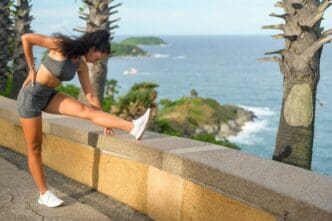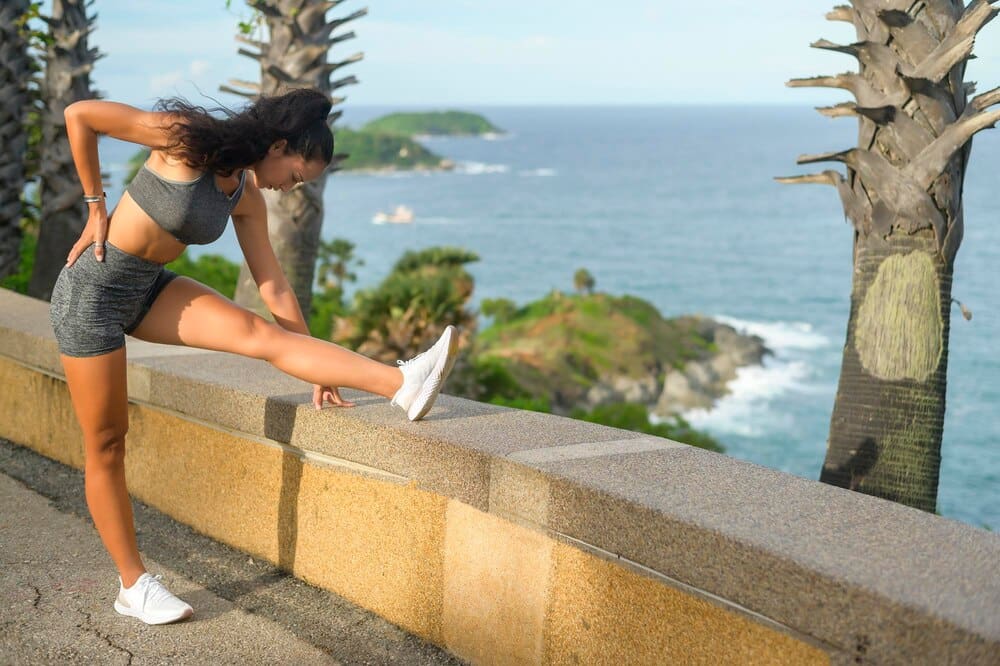For South Florida runners battling year-round heat, oppressive humidity, and unforgiving pavement, a strong, stable core is the non-negotiable foundation for improving performance and preventing injury. By stabilizing the pelvis and spine, a dedicated core routine enables runners to maintain efficient form even when fatigue sets in, transfer power more effectively from the ground up, and reduce the repetitive stress that leads to common ailments like runner’s knee, IT band syndrome, and lower back pain. Integrating specific, functional core exercises two to three times per week is a critical training component for any runner—from the weekend warrior on the Hollywood Broadwalk to the marathoner training on A1A—looking to build resilience and unlock new levels of speed and endurance in the Sunshine State.
Why Core Strength is a Runner’s Secret Weapon
Many runners mistakenly associate core work with achieving a “six-pack.” While aesthetic benefits can be a byproduct, the true value for an athlete lies in function, not appearance. Your core is the central link in a kinetic chain that connects your upper and lower body, acting as a crucial power transfer station.
A strong core provides a stable platform for your limbs to operate from. As you run, your arms and legs move in opposition, generating rotational forces through your torso. A well-conditioned core resists these forces, keeping your pelvis and spine stable and preventing wasteful, side-to-side movement. This allows more of your energy to be channeled into forward propulsion.
Think of it like trying to fire a cannon from a canoe. Without a stable base, much of the cannon’s power is lost as the canoe rocks and wobbles. A strong core is the stable, concrete platform that allows you to unleash your full power with every stride, making your running more efficient and economical.
Furthermore, this stability is your primary defense against injury. When the core muscles fatigue and fail, other smaller, less-equipped muscles are forced to take over stabilization duties. This compensation is a direct path to overuse injuries, as these muscles are not designed for that role.
The South Florida Challenge: Heat, Humidity, and Flat Terrain
Running in South Florida presents a unique set of physiological challenges that make core strength even more vital. The persistent heat and high humidity accelerate dehydration and elevate core body temperature, leading to faster-than-normal fatigue. As fatigue mounts, running form is often the first casualty.
When you get tired, your shoulders may slump, your hips may drop, and your stride may become sloppy. A robust core acts as an internal scaffold, helping you maintain an upright posture and stable pelvis long after fatigue has begun to compromise your form. This resilience is key to finishing long runs strong and safely in a demanding climate.
Additionally, the region’s notoriously flat terrain, while seemingly easy, creates its own problems. The lack of hills means your body is subjected to a highly repetitive, monotonous impact pattern, primarily on hard surfaces like asphalt and concrete. This relentless pounding can wreak havoc on your joints.
A stable core helps to absorb and dissipate these impact forces more effectively throughout the body, rather than concentrating them in the knees, hips, or lower back. By controlling pelvic motion and preventing excessive hip drop with each footstrike, you protect your joints from thousands of micro-traumas over the course of a run.
The Anatomy of a Runner’s Core
To train the core effectively, you must first understand that it’s a complex, three-dimensional system of muscles. It extends far beyond the rectus abdominis, the superficial muscle responsible for the six-pack appearance. A truly functional core includes deep inner muscles and major muscle groups in the back and hips.
Key players include the transverse abdominis, which acts like a natural corset to stabilize the spine; the internal and external obliques, which control rotation and side-bending; the erector spinae, which run along your spine and help you stay upright; and, critically for runners, the glutes and hip flexors, which power your stride and stabilize your pelvis.
Therefore, an effective core routine for runners must move beyond endless crunches. It should incorporate exercises that challenge stability in all planes of motion: resisting extension (arching the back), resisting rotation (twisting), and resisting lateral flexion (side-bending).
The Ultimate Core Workout for South Florida Runners
This workout focuses on functional exercises that build the kind of stability runners need. The goal is to teach your body to hold a rigid torso while your limbs are in motion. For each exercise, focus intently on perfect form; quality is always more important than quantity.
1. The Plank (Anti-Extension)
The classic plank is a foundational exercise that teaches you to resist the pull of gravity on your spine, a skill that directly translates to maintaining good posture during the later stages of a run.
How to do it: Lie face down and prop your body up on your forearms and toes, keeping your body in a straight line from your head to your heels. Engage your glutes and brace your abdomen as if you’re about to be punched in the stomach. Do not let your hips sag or rise too high. Hold for 30-60 seconds.
Runner’s Benefit: Builds isometric strength and endurance in the entire core musculature, promoting spinal stability under load.
Progression: To increase the challenge, try lifting one leg a few inches off the ground for 5-10 seconds, then switching, all while keeping your hips perfectly level.
2. The Side Plank (Anti-Lateral Flexion)
This variation is crucial for runners as it strengthens the muscles, like the gluteus medius and obliques, that prevent the hip from dropping on the non-stance leg during the running gait. This “pelvic drop” is a major contributor to IT band syndrome and runner’s knee.
How to do it: Lie on your side with your legs straight, propped up on one forearm. Your elbow should be directly under your shoulder. Lift your hips off the ground until your body forms a straight line. Hold for 20-45 seconds per side.
Runner’s Benefit: Directly strengthens the lateral stabilizers of the hip and core, improving pelvic stability with every footstrike.
Progression: Add hip “dips,” where you lower your hip toward the floor and then raise it back up. For a greater challenge, raise your top leg.
3. The Bird-Dog (Anti-Rotation)
Running is a cross-body activity. As your right arm swings forward, so does your left leg. The bird-dog mimics this pattern, training your core to remain stable while your opposite limbs are in motion.
How to do it: Start on all fours in a tabletop position. Simultaneously extend your right arm straight forward and your left leg straight back, keeping your back flat and your hips level. Pause for a second, then slowly return to the start. Perform 10-12 reps per side.
Runner’s Benefit: Enhances coordination and proprioception while building stability across the posterior chain and resisting rotational forces.
Progression: Slow the movement down significantly. A 3-second extension and 3-second return makes the exercise much more demanding on your stabilizers.
4. The Dead Bug (Spinal Stability)
The dead bug is one of the safest and most effective exercises for teaching your brain to keep your lumbar spine stable while your limbs move, which is the very definition of what your core needs to do when you run.
How to do it: Lie on your back with your arms extended toward the ceiling and your knees bent at 90 degrees over your hips. Press your lower back gently into the floor. Slowly lower your right arm and left leg toward the floor simultaneously, going only as low as you can without your lower back arching. Return to the start and repeat on the other side. Perform 10-15 reps per side.
Runner’s Benefit: Decouples limb movement from the spine, a fundamental skill for efficient running mechanics.
Progression: Hold a light dumbbell in each hand or strap on ankle weights to increase the lever length and challenge.
5. The Glute Bridge (Posterior Chain Power)
Many runners are “quad-dominant” and have weak, underactive glutes—your body’s most powerful muscle group. The glute bridge “wakes up” and strengthens the glutes, which are your engine for forward propulsion.
How to do it: Lie on your back with your knees bent, feet flat on the floor hip-width apart. Drive through your heels to lift your hips toward the ceiling until your body forms a straight line from your shoulders to your knees. Squeeze your glutes at the top, pause, and lower slowly. Perform 15-20 reps.
Runner’s Benefit: Activates and strengthens the glutes and hamstrings, improving power output and reducing the strain on the lower back.
Progression: Progress to a single-leg glute bridge, which adds a significant stability challenge.
Building Your Core Routine: When and How Often
Consistency is more important than intensity. Aim to perform a dedicated core workout two to three times per week on non-consecutive days to allow for recovery. A 15-20 minute session is all you need to see significant benefits.
The best time to do your core work is either as a separate, standalone session or immediately following an easy run. Avoid performing an exhaustive core workout right before a hard interval session or a long run, as you don’t want to pre-fatigue the stabilizing muscles that you’ll rely on during your key workouts.
Sample 15-Minute Routine
Perform the following circuit two to three times, resting for 60 seconds between circuits.
- Plank: 45-second hold
- Side Plank: 30-second hold per side
- Bird-Dog: 10 slow reps per side
- Dead Bug: 12 reps per side
- Glute Bridge: 15 reps
Conclusion: Your Foundation for a Lifetime of Running
In the challenging running environment of South Florida, a strong core is not a luxury—it is an absolute necessity. It is the silent, hardworking partner that protects you from injury, helps you maintain form when the heat drains your energy, and allows you to translate your hard-earned fitness into real-world speed. By moving beyond crunches and embracing functional, stability-focused exercises, you are making a long-term investment in your running health, performance, and longevity. This is the resilient foundation upon which every strong, efficient, and joyful stride is built.







